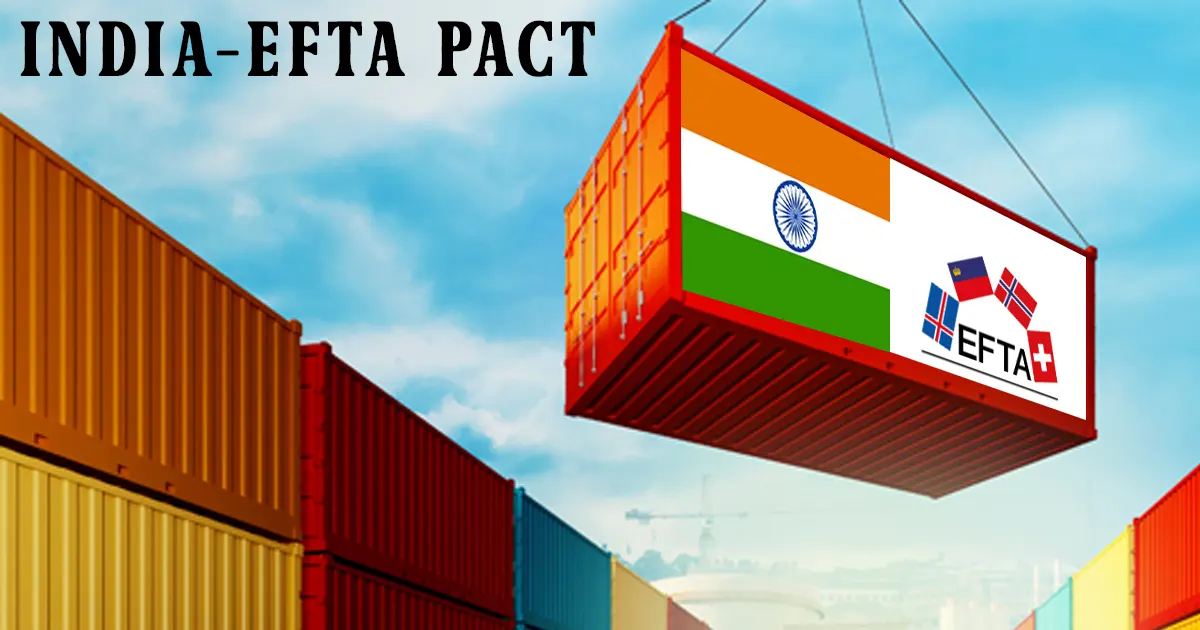GS 2 – International Relation

Trade and Economic Partnership Agreement (TEPA) is to foster investments and enhance exports, with a special focus on India’s IT, audio-visual sectors, and the mobility of skilled professionals.
Date of Signing: March 10, 2024
Participants: India and EFTA member countries: Iceland, Liechtenstein, Norway, and Switzerland.
Investment Commitment:
- EFTA nations aim to boost Foreign Direct Investment (FDI) in India by $50 billion within the next decade, with an additional $50 billion planned for the following five years.
Noteworthy Inclusion:
- For the first time, the agreement incorporates a dedicated chapter on human rights and sustainable development.
Implementation Timeline:
- The pact will be operational after ratification by EFTA member countries, likely by the year-end.
Potential Advantages for India
- Reduction in Tariffs:
- Tariff cuts will apply to most industrial exports from EFTA nations to India, including machinery, pharmaceuticals, watches, fertilizers, chemicals, and more.
- Boost to Trade and Investments:
- EFTA investments, which reached $10.7 billion in 2022, are set to rise further. Switzerland remains India’s primary trading partner in this group, followed by Norway.
- Job Creation:
- The projected $100 billion FDI inflow over 15 years could generate up to one million direct jobs in India.
- Enhanced Market Access:
- The agreement will open up EFTA markets to Indian exports, offering greater opportunities for Indian products.
- Services Sector Gains:
- Significant growth is anticipated in the services sector, particularly in IT and the movement of skilled professionals.
Challenges for India
- Trade Imbalance with Switzerland:
- In 2023, Indian exports to EFTA totaled $1.87 billion, with Switzerland alone accounting for $1.38 billion. However, 98% of these exports already enter at zero tariffs, limiting potential benefits from the agreement.
- Exclusion of Agricultural Products:
- While India has offered concessions on 82.7% of its tariff lines, agricultural goods remain largely excluded from the deal.
- Limited Market Access Scope:
- Despite the agreement, the scope for increased market access in EFTA remains low. India recorded a trade deficit of $18.58 billion with the bloc in 2023, driven mainly by gold and precious metal imports from Switzerland. These imports accounted for $16.7 billion, with gold alone representing 80% of the total.
- Minimal Competition in JV Areas:
- The joint ventures identified under the pact are in sectors where India faces limited competition, reducing the potential for competitive gains.
Path Forward
India has set an ambitious target of achieving $2 trillion in exports of goods and services by 2030. To reach this milestone, the government needs to:
- Implement policy measures to reduce tariffs.
- Pursue deeper and broader free trade agreements.
- Safeguard national interests while negotiating such pacts.
- Ensure that the benefits of trade agreements are maximized through effective policy implementation.




